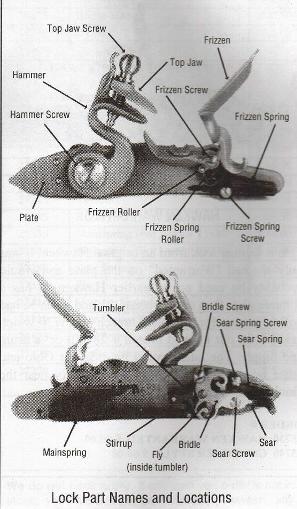|
History of the flintlock

When one considers the history of firearms in general, it is historically evident that the flintlock system of ignition endured,
in one form or another, longer than any other type.
The flintlock system, as we know it today, was invented
around 1630 (dates are in conflict on this) and continued until Rev. Alexander Forsyth invented the percussion system in 1807.
So the relatively short periods of percussion and cartridge guns is overwhelmed by the long reign of the flintlocks.
In present days muzzleloading, the flintlock is still the name of the game for the true traditionalist, be they Buckskinners,
Mountain Men, Primitives, or just the average hunter/shooter. Shooting the flintlocks in any form, ie. rifle, shotgun, or
pistol has changed very little since the Penna./Ky. rifle was used on the early frontiers, and the same conditions exist,
in the methods of firing, loading and cleaning that existed at that time.
To shoot a flintlock is (at least to
me) like walking back in time and experiencing things the way our forefathers did many years ago.
The basic way
a flintlock works is that a flint strikes the frizzen, scrapes tiny bits of metal off the frizzen that become white hot, falls
into the pan, which has priming powder in it, thereby setting off the main charge of powder in the barrel. Sounds simple enough
huh? Well if you've shot flintlocks any legnth of time you'll sooner or later discover that flintlocks do have a charm all
their own and have been a source of aggravation for many shooters. While the process of ignition is a simple one, one must
make sure of a few things to ensure that almost instant ignition. First and foremost is your frizzen. It must be HARD! Nothing
will drive a shooter crazier than a soft frizzen. If a new shooter gets a flintlock with a soft frizzen he or she may not
realize what the problem is and overlook this one very important piece of the puzzle. When a frizzen is properly hardened
a file will not bite into it. It will simply skate over it. A soft frizzen when struck with a flint will often time gouge
the frizzen face. Testing it with a file can tell you for sure if the frizzen is properly hardened. If it is not you should
get a replacement frizzen for your lock and either install it yourself or have it installed for you.
Another
source of frustration for alot of people is the flints. There are about as many flints on the market as there are shooters
nowadays. If you live in an area where flintlocks are a rarity and have to settle for mail order suppliers to assist you then
it becomes a crap shoot whether or not you will get quality flints. I know as I've been there. There are several sporting
goods stores near me, however they are stocked in caplock supplies with no flints in stock. Or the flints they do have are
cut Arkansas flints like the type that you would get if you purchased a set of T/C flints. Now some people may get good ignition
with them however I've not had much luck with them. I'm not trying to sell any product over another. This site is to give
direction and to tell you what I have found that works for me. I tried the cut Arkansas flints, and several types of mail
order flints. Ignition was a little better with the mail order flints but I never knew how many shots I'd get before they
broke. Then a new product came on the market called a duraflint. They are the hardest flint I have ever tried. They are so
hard it takes a diamond file to sharpen them! Once we started using these flints, ignition time was right up there with a
caplock which is where it should be.
Another thing alot of beginner's have problems with is determining exactly
the size flint they need to go into their lock. This is not as difficult as it seems although that each lock is made in different
sizes. The way to determine what size you need is to put the hammer on half cock and close the frizzen over the pan. Once
this is done measure the distance between the top jaw screw and the frizzen face. Subtract 1/8" of an inch which will
be for the flint leather and you have found the size you need.
Another source of frustration to some is how
much to prime the pan. This is a trial and error to see what your particular rifle likes. I have 2 flintlocks and they like
to be primed differently. One likes about a 1/2 of a pan full of powder. The other one likes about 2/3. Just play around with
the amount of priming powder and you will soon get the idea of what your lock likes. Also just remember when priming to keep
the priming powder from covering the touch hole liner. To do so in effect makes the priming charge a fuse which the sparks
of the frizzen have to burn through to get to the main charge resulting in longer ignition. You ideally want your touch hole
liner to be level with the pan. If you were to take and draw an imaginary line across the pan you would want your touch hole
liner's hole to be right in the middle. Another thing that will help with ignition and fouling is to have a touch hole liner
that is coned on both the inside and the outside. The hole itself should be 1/16". By double-coning on inside and outside
it helps ignition. The inside cone brings the main charge up closer to the priming charge. The outside cone in effect funnels
the sparks into the main charge and also is somewhat self cleaning. Thus reducing the need to run a vent pick into the touch
hole liner as often.
|




